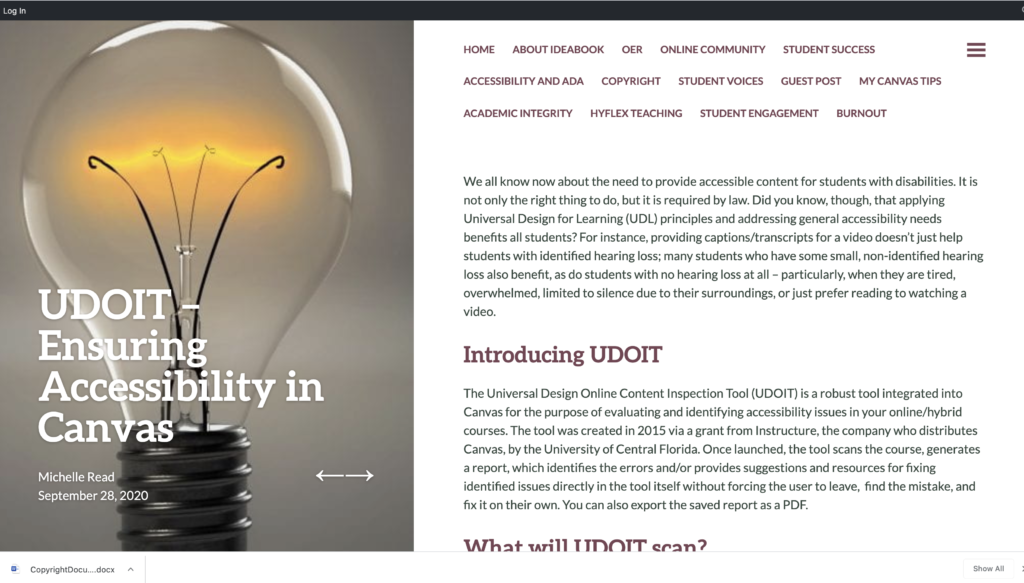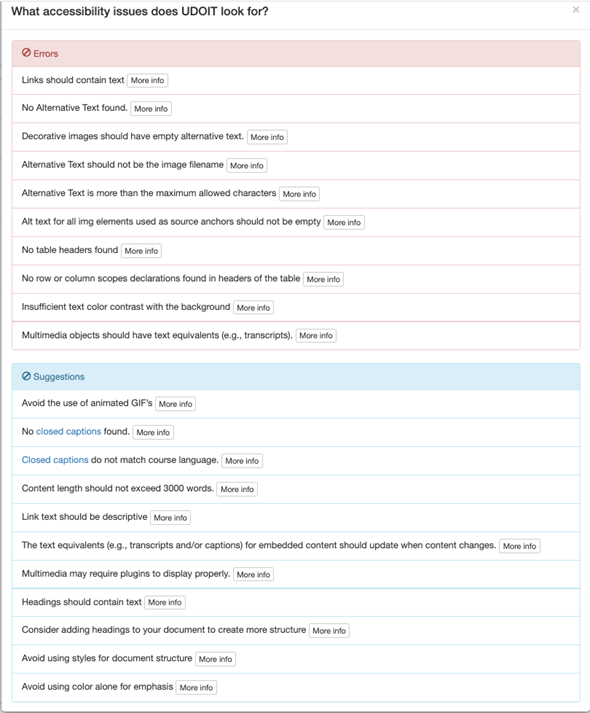When Texas State University adopted Canvas, we quickly also adopted a tool for use in Canvas called UDOIT. This is a tool that searches for accessibility issues in the course pages. This blog post explains what UDOIT is, why it is important, and how to use it.

We all know now about the need to provide accessible content for students with disabilities. It is not only the right thing to do, but it is required by law. Did you know, though, that applying Universal Design for Learning (UDL) principles and addressing general accessibility needs benefits all students? For instance, providing captions/transcripts for a video doesn’t just help students with identified hearing loss; many students who have some small, non-identified hearing loss also benefit, as do students with no hearing loss at all – particularly, when they are tired, overwhelmed, limited to silence due to their surroundings, or just prefer reading to watching a video.
Introducing UDOIT
The Universal Design Online Content Inspection Tool (UDOIT) is a robust tool integrated into Canvas for the purpose of evaluating and identifying accessibility issues in your online/hybrid courses. The tool was created in 2015 via a grant from Instructure, the company who distributes Canvas, by the University of Central Florida. Once launched, the tool scans the course, generates a report, which identifies the errors and/or provides suggestions and resources for fixing identified issues directly in the tool itself without forcing the user to leave, find the mistake, and fix it on their own. You can also export the saved report as a PDF.
What will UDOIT scan?
UDOIT will scan:
- Announcements
- Assignments
- Discussions
- Files
- Pages
- Syllabus
- Module URLs
- Unpublished content
What are the Tool’s Limitations?
Tool limitations currently include its inability to scan all files, particularly external documents and some audio/video files. Additionally, you must remain on the UDOIT page while the course is being scanned. Finally, the tool is not considered a certification that the course is deemed “accessible”. It simply provides guides. The following screenshot shows exactly what UDOIT is scanning for in the course. Note the list of suggestions following the list of errors.
More Information
The source code for the tool is licensed under the GPL V3 open source license, meaning it is free to use.
Please use the UDOIT-UserGuide for instructions on how to launch and work with the UDOIT accessibility scanning tool for Canvas LMS.
Please check out our other blog posts on Accessibility to learn about:
- Making PDFs Work for Everyone (This post focuses on converting and creating PDFs, the reasons for doing so, and how to make sure they are accessible.)
- Is Your Course Accessible for All? (This link provides information on how to make your Word, PowerPoint, PDFs, etc., accessible and how to check the accessibility of each type along with some basic tips to consider).
To hear more about student concerns related to online/hybrid courses and accessibility, check out:
- Student Voices: Reflections of a Student with Dyslexia
- Student Voices: Reflections of a Visually Impaired Student
Conclusion
As a recent email from our provost suggest, the use of captions and transcripts benefit everyone. In keeping with the principles of UDL, making material accessible also benefits everyone. Be proactive! Make accessibility a top priority, one you consider and apply during design and creation.
Resources
Bates, TRJ. (2016). UDOIT Information. Canvas Community. https://community.canvaslms.com/t5/Accessibility/UDOIT-Information/ba-p/242723
DOOIT/ITAC. (n.d.). UDOIT. Texas State University. https://itac.txstate.edu/support/canvas/lti/udoit.html
UCF’s Center for Distributed Learning. (2016). Universal Design Online Content Inspection Tool (UDOIT). University of Central Florida. https://cdl.ucf.edu/teach/accessibility/udoit/
